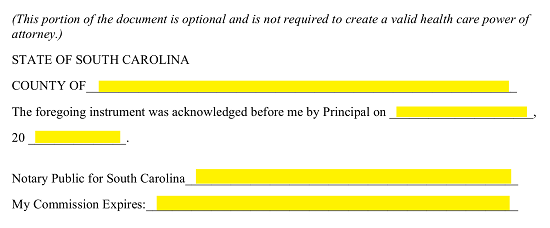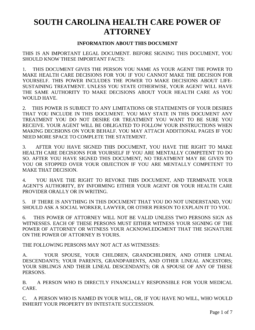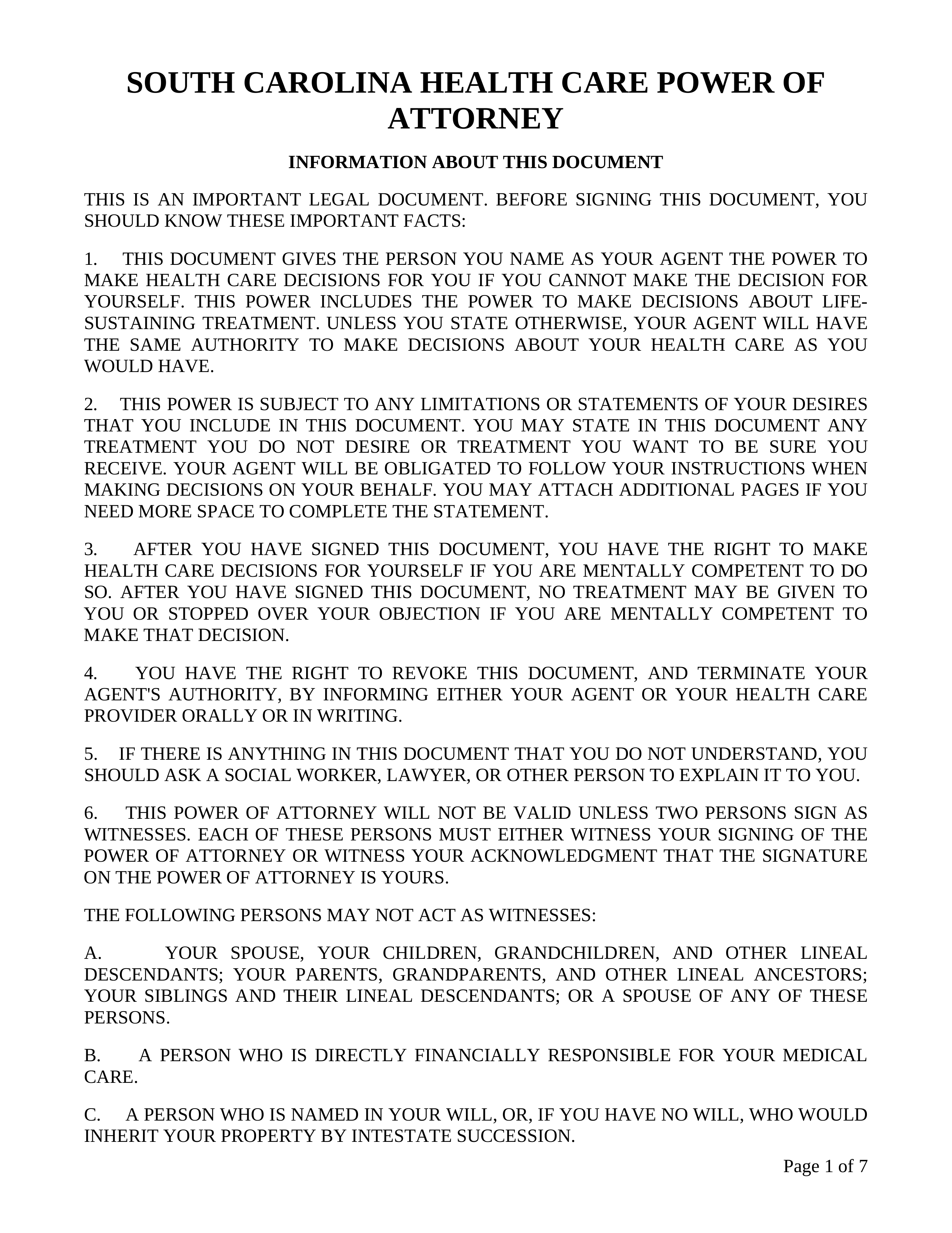Updated August 09, 2023
A South Carolina medical power of attorney is a document that allows a principal to transfer rights to an agent and make health care decisions on their behalf. The form only becomes in effect in the event the principal is legally disabled. The principal may select up to two (2) alternate agents in the chance the first (1st) agent is not able to act on their behalf.
Definition
“Health care power of attorney” means a durable power of attorney executed in accordance with this part.
Laws
- Signing Requirements – Two (2) witnesses (§ 62-5-504(9)(B)). If including a declaration to withhold life-sustaining procedures through a living will or form pursuant to § 44-77-50, the principal must also date and sign before a notary public, who may act as one of the two witnesses (44-77-40).
- Statutes – Title 62, Article 5 (Protection of Persons Under Disability and Their Property)
How to Write
Download: PDF
1 – The Paperwork Used To Officially Declare A Health Care Representative Is Downloadable Here
You may download this using this page. Simply locate the buttons under the template picture on this page then select the format you wish to work with.
2 – The First Part Requests Party Identification
The first part “Designation Of Health Care Agent” will have some blank areas that require attention. Input the Principal’s Full Name in the first blank area. This will begin the declarative statement this document requires. 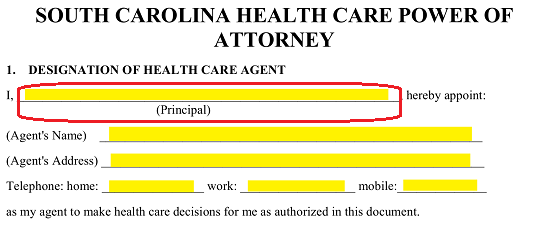
Now, locate the blank lines labeled “Agent’s Name,” “Agent’s Address,” “Home,” “Work,” and “Mobile.” Utilize the spaces provided in this area to record the Full Name and Residential Address of the person who will act as the Health Care Representative for the Principal named above. In addition to the Physical Residential Address, report the Health Care Representative’s contact Home Phone Number, Daytime Work Number, and Cell Phone Number. 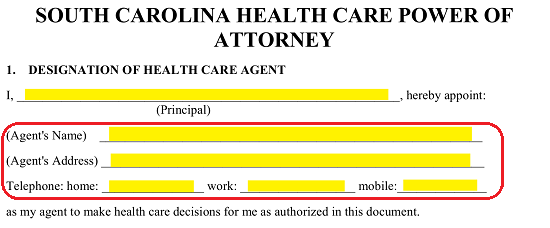 In addition to the Health Care Agent, the Principal can also designate an Alternate Agent. Such an entity is useful because he or she will not have Principal Power but retains the Principal Approval to seize and wield Principal Authority if the Principal is incapacitated and the Health Care Agent can/will not act as the Principal’s Health Care Agent. In order for this entity to assume the mantle of Principal Health Care Agent in such a scenario, his or her Name, Home Address, and Contact Telephone numbers (“Home,” “Work,” “Mobile”) must be recorded in item “a. First Alternate Agent.”
In addition to the Health Care Agent, the Principal can also designate an Alternate Agent. Such an entity is useful because he or she will not have Principal Power but retains the Principal Approval to seize and wield Principal Authority if the Principal is incapacitated and the Health Care Agent can/will not act as the Principal’s Health Care Agent. In order for this entity to assume the mantle of Principal Health Care Agent in such a scenario, his or her Name, Home Address, and Contact Telephone numbers (“Home,” “Work,” “Mobile”) must be recorded in item “a. First Alternate Agent.”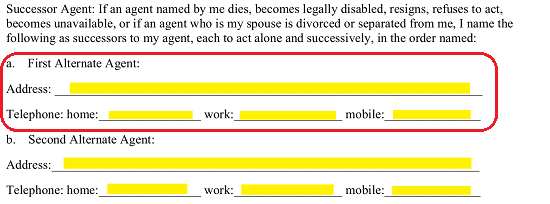 In “b. Second Alternate Agent,” an entity can be named to act as the Health Care Agent if the Principal is rendered disabled, and both the Health Care Agent and First Alternate Agent are not able to or allowed to use Principal Power. To set up this entity, enter his or her Full Name, Residential Address and Telephone Numbers in the blank spaces for “b. Second Alternate Agent.”
In “b. Second Alternate Agent,” an entity can be named to act as the Health Care Agent if the Principal is rendered disabled, and both the Health Care Agent and First Alternate Agent are not able to or allowed to use Principal Power. To set up this entity, enter his or her Full Name, Residential Address and Telephone Numbers in the blank spaces for “b. Second Alternate Agent.”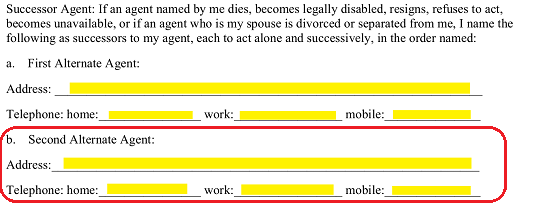
3 – The Principal Should Read The Default Powers Then Determine Their Status
The Health Care Agent’s Principal Powers and Authority are included and well defined in Part “4. Agent Powers” but should be reviewed by the Principal before he or she signs this document. 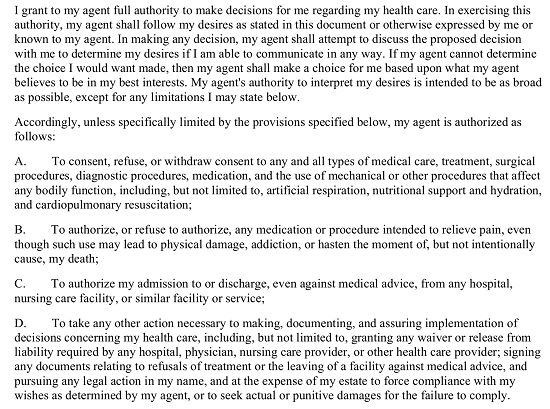 The Principal, delivering these Powers, will have the ultimate say in what Principal Powers are assigned to the Health Care Agent here. He or she may adjust the Powers granted by limiting them in Part 4E. Several blank lines have been supplied so that a complete report on any limitations, restrictions, extensions, or additions of Principal Power that should be applied to the Health Care Agent’s use of these Powers can be presented with this document. If there is not enough room, you may continue on an attachment so long as the attachment is properly labeled and accompanies this document when it is presented to the Principal for signing.
The Principal, delivering these Powers, will have the ultimate say in what Principal Powers are assigned to the Health Care Agent here. He or she may adjust the Powers granted by limiting them in Part 4E. Several blank lines have been supplied so that a complete report on any limitations, restrictions, extensions, or additions of Principal Power that should be applied to the Health Care Agent’s use of these Powers can be presented with this document. If there is not enough room, you may continue on an attachment so long as the attachment is properly labeled and accompanies this document when it is presented to the Principal for signing.
4 – Some Post-Partum Directives May Be Included
This document will also contain the language required to define the Principal’s stance on Anatomical Gifts. In Part “5. Organ Donation” the Principal should either initial the first blank line to indicate the Health Care Agent has Principal Approval to consent to organ donations or initial the second blank line to indicate the Health Care Agent does not have Principal Approval to donate any organs or tissues on behalf of the Principal.
5 – A Report On Life Sustaining Scenarios Should Be Addressed
The Principal should now turn his or her attention to Part “7. Statement Of Desires Concerning Life-Sustaining Treatment.” In this scenario, the Principal has suffered a traumatic medical event and cannot live without Medical Assistance or Medical Technology. If the Principal does not wish his or her life prolonged when such Treatment is necessary and is overburdensome with unsatisfactory benefits to maintain a quality of life the Principal prefers then, he or she should initial statement “(1)”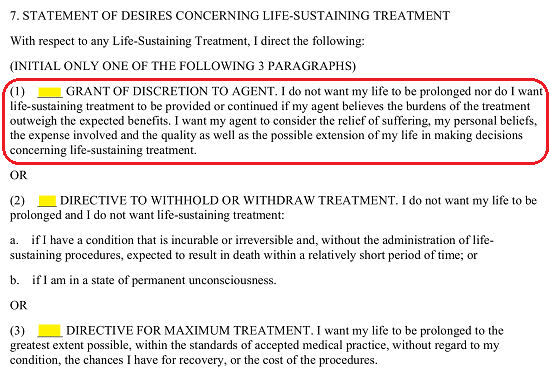 If the Principal generally wants Life-Sustaining Treatment when necessary but prefers Life-Sustaining Treatment to be withheld only if he or she has a terminal condition that results in death in a short amount of time or when he or she is in a state of “Permanent Unconsciousness,” then the Principal should initial “(2).”
If the Principal generally wants Life-Sustaining Treatment when necessary but prefers Life-Sustaining Treatment to be withheld only if he or she has a terminal condition that results in death in a short amount of time or when he or she is in a state of “Permanent Unconsciousness,” then the Principal should initial “(2).”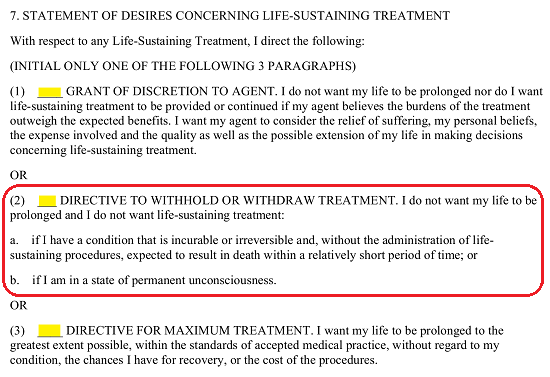 If the Principal wishes to receive Life-Sustaining Treatment regardless of his or her condition (within reason and the confines of the law) then he or she should initial “(3)”
If the Principal wishes to receive Life-Sustaining Treatment regardless of his or her condition (within reason and the confines of the law) then he or she should initial “(3)”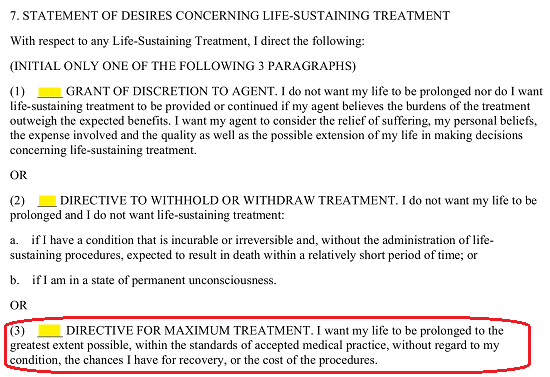 To continue this scenario, we will now discuss when Life-Sustaining Treatment involves being Tube Fed in “8. Statement Of Desires Regarding Tube Feeding.” If this is a part of Life-Sustaining Treatment the Principal can tighten his or her preferences by initialing one of the following three choices.
To continue this scenario, we will now discuss when Life-Sustaining Treatment involves being Tube Fed in “8. Statement Of Desires Regarding Tube Feeding.” If this is a part of Life-Sustaining Treatment the Principal can tighten his or her preferences by initialing one of the following three choices.
If the Principal does not want his or her life prolonged through Tube Feeding that drastically compromises his or her quality of life and is overburdensome then he or she must initial “(a)”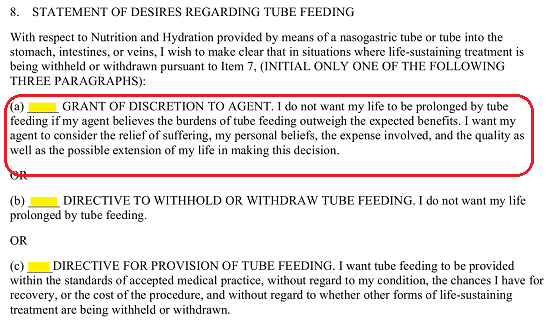
If the Principal does not want to be Tube Fed under any circumstances, then he or she should initial “(b).”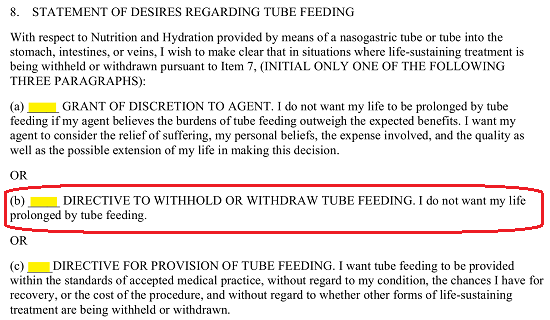
The Principal may elect to have his or her life prolonged through Tube feeding regardless of the burdens or the chances of his or her recovery. If so, then he or she should initial “(c).”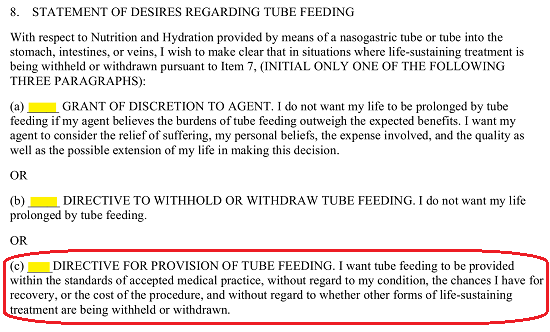
6 – Only The Principal Can Sign And Execute These Directives
In Part “9. Administrative Provisions,” the Principal will both revoke previous Health Care Authorities (this does not apply to Living Wills) and execute the Powers in this document into a state of being Effective. First, the Principal will need to locate the blank lines in the sentence “I Sign My Name To This Health Care Power Of Attorney On This” then, enter the Calendar Day, Month, and Year when he or she signs this document.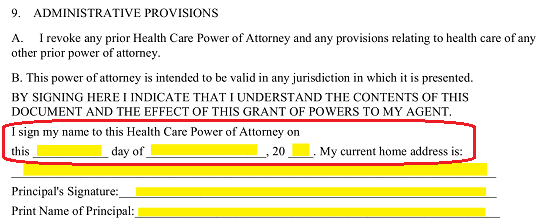
After supplying the Signature Date, the Principal should also submit his or her Residential Address on the next blank line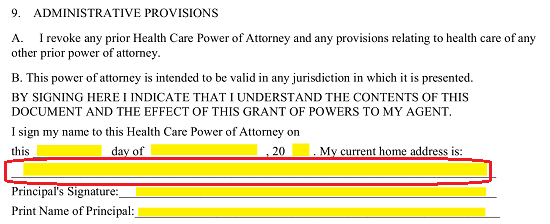
Now that the Principal has recorded the Signature Date, he or she must sign the blank line following the label “Principal’s Signature.” Immediately below this, the Principal must print his or her Name on the “Print Name Of Principal.”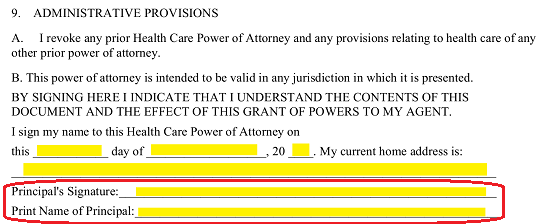
The paragraph beneath the Principal Signature area is a Witness Statement. The wording here will verify that each Signature Witness has physically observed the Principal Signing and is qualified to be a Witness. Two areas “Witness No. 1” and “Witness No. 2” have been supplied below this statement so that each Witness can sign a unique “Signature” line then supply the Date of his or her Signature, and his or her Printed Name.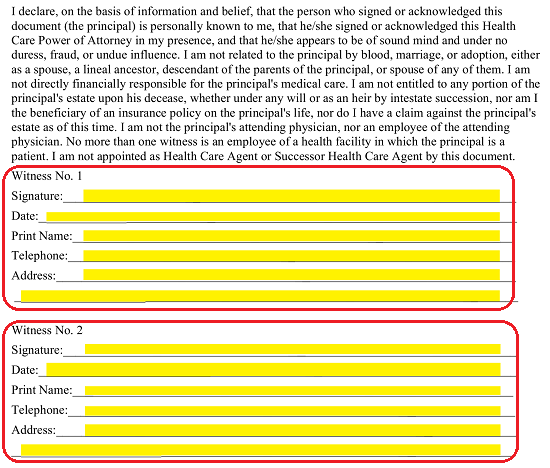
The final area of this paperwork is structured exclusively for the use of the Notary Public obtained to notarize the Principal Signature. It should be noted that it is not mandatory to have this directive notarized (though it must be signed by the Principal and two qualifying Witnesses), most would consider it wise to notarize the Principal Signing of such a delegation.